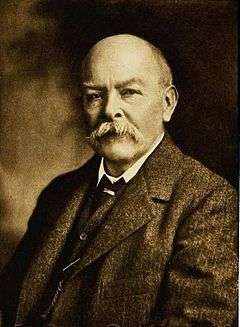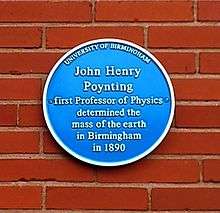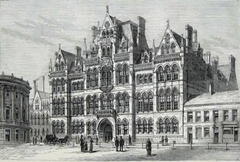John Henry Poynting
| John Poynting | |
|---|---|
 John Henry Poynting (1852–1914) | |
| Born |
9 September 1852 Monton, Lancashire, England |
| Died |
30 March 1914 (aged 61) Birmingham, England |
| Residence | England |
| Nationality | English |
| Alma mater |
University of Cambridge Owens College (now University of Manchester) |
| Known for |
Poynting vector Poynting effect Poynting's theorem Poynting–Robertson effect |
| Awards |
Adams Prize (1893) Hopkins Prize (1893) Royal Medal (1905) |
| Scientific career | |
| Fields | Physicist |
| Institutions | Mason Science College, University of Birmingham |
| Academic advisors | James Clerk Maxwell |
| Notable students | Francis William Aston |
| Influences | Edward Routh |
| Signature | |
|
| |
John Henry Poynting (9 September 1852 – 30 March 1914[1][2]) was an English physicist. He was a professor of physics at Mason Science College, from 1880 to 1900, and then the successor institution, the University of Birmingham until his death.
Biography
Poynting was the youngest son of Thomas Elford Poynting, a Unitarian minister. He was born at the parsonage of the Monton Unitarian Chapel in Eccles, Lancashire (his father serving as minister there from 1846 to 1878.) In his boyhood he was educated at the nearby school operated by his father. From 1867 to 1872 he attended Owens College, now the University of Manchester, where his physics teachers included Osborne Reynolds and Balfour Stewart. From 1872 to 1876 he was a student at Cambridge University, where he attained high honours in mathematics after taking grinds with Edward Routh. In the late 1870s he worked in the Cavendish Laboratory at Cambridge under James Clerk Maxwell.[3]
He was the developer and eponym of the Poynting vector, which describes the direction and magnitude of electromagnetic energy flow and is used in the Poynting theorem, a statement about energy conservation for electric and magnetic fields. This work was first published in 1884. He performed a measurement of Newton's gravitational constant by innovative means during 1893. In 1903 he was the first to realise that the Sun's radiation can draw in small particles towards it:[4] this was later named the Poynting–Robertson effect.
He discovered the torsion-extension coupling in finite strain elasticity. This is now known as the (positive) Poynting effect in torsion.
Poynting and the Nobel prizewinner J. J. Thomson co-authored a multi-volume undergraduate physics textbook, which was in print for about 50 years and was in widespread use during the first third of the 20th century.[5] Poynting wrote most of it.[6]
He was awarded an honorary MSc in Pure Science in 1901 by Birmingham University.[7]
Poynting lived at 11 St Augustine's Road, Edgbaston with his family and servants for some years. He previously lived at 66 Beaufort Road, Edgbaston (demolished) and died of a diabetic coma, aged 61, at 10 Ampton Road, Edgbaston in 1914.
Legacy
Poynting's most famous student may have been Alfred J. Lotka, who was inspired by Poynting to apply the ideas of physical chemistry to biology. Lotka dedicated his classic book on mathematical population biology to Poynting.


Craters on Mars and the Moon are named in his honour, as is the main Physics building at the University of Birmingham and the departmental society there, the Poynting Physical Society. He is credited with coining the expression "greenhouse effect" in 1909 to explain how human behaviour might increase global temperatures. .[8]
Works by J. H. Poynting
- 1884 A Comparison of the Fluctuations in the Price of Wheat and in the Cotton and Silk Imports into Great Britain, Journal of the Royal Statistical Society; 47, 1884, pp. 34–64
- 1911 A Text-book of Physics: volume III: Heat London, C. Griffin
- 1913 The earth; its shape, size, weight and spin Cambridge University Press
- 1914 A Text-book of Physics: Electricity and Magnetism. Pts. I and II: Static electricity and magnetism London, C. Griffin
- 1920 Collected Scientific Papers Cambridge University Press
References
- ↑ GRO Register of Births: DEC 1852 8c 391 BARTON – John Henry Poynting, mmn = unknown
- ↑ GRO Register of Deaths: MAR 1914 6d 128 KING'S N. – John Henry Poynting, aged 61
- ↑ John Henry Poynting's biography at Institute of Physics.
- ↑ Benest, Daniel; Froeschlé, Claude (1992). Interrelations Between Physics and Dynamics for Minor Bodies in the Solar System. Atlantica Séguier Frontières. p. 437. ISBN 2-86332112-9. Extract of page 437
- ↑ For a lengthy though incomplete listing of the editions of Poynting and Thomson's Text-book of Physics see Worldcat.org.
- ↑ Reported in the biography of JJ Thomson by Davis & Falconer, previewable at Google Book Search Preview.
- ↑ "University campus Blue Plaque Trail". Birmingham University. Retrieved 12 November 2014.
- ↑ "On Prof. Lowell's method for evaluating the surface-temperatures of the planets; with an attempt to represent the effect of day and night on the temperature of the earth", Phil. Mag. Vol 14 p 749 (1907)
External links


